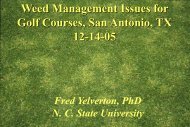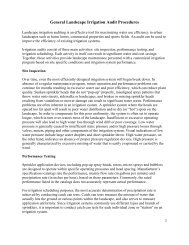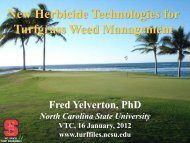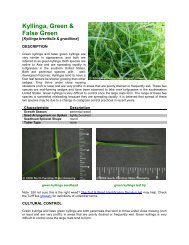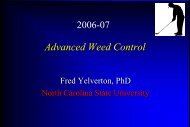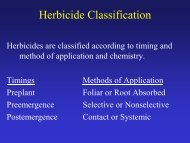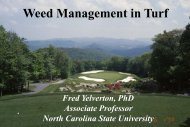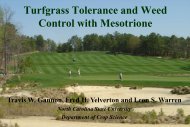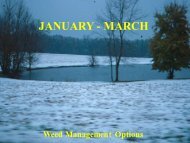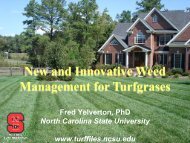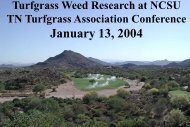Carolina Athletic Fields: - TurfFiles - North Carolina State University
Carolina Athletic Fields: - TurfFiles - North Carolina State University
Carolina Athletic Fields: - TurfFiles - North Carolina State University
- No tags were found...
You also want an ePaper? Increase the reach of your titles
YUMPU automatically turns print PDFs into web optimized ePapers that Google loves.
Table 2. Suggested weed management calendar for bermudagrass sports fields. Note that recommendations varydepending on overseeding status.MonthFebruary 1 toMarch 15May through JuneMay through JulyLate July throughmid-AugustMid-August toSeptember 17 days prior tooverseedingMid-September toend of SeptemberOctober 15 toDecember 15Early Novemberthrough DecemberLate November untilend of DecemberMid-January to Mid-FebruaryWeed Control PracticeApply a preemergence herbicide for crabgrass and goosegrass control. Repeat in 8-10 weeks. If severe trafficdamage, spring dead spot, or winter kill to the bermudagrass is evident or suspected, use a herbicide containingoxadiazon (e.g., Ronstar or Regalstar). If the field is not severely worn or damaged, any preemergence herbicideis safe.Repeat preemergence herbicide use 8 to 10 weeks following the March application for season-long control. Ifcrabgrass or broadleaf weeds emerge, use a postemergence product. Repeat in 7 to 10 days as directed by label.For purple or yellow nutsedge, or other perennial sedges, use a postemergence product. Repeat in 4 weeks or asdirected by label.If the field is to be overseeded, a preemergence herbicide for annual bluegrass control should be considered.Consult label for overseeding intervals.Apply preemergence herbicide for Poa annua control for sports fields not to be overseeded. Use label rates ofBarricade, Dimension, Pendimethalin, or Surflan .For overseeded fields, apply foramsulfuron (Revolver) or rimsulfuron (TranXit) for annual bluegrass control.For non-overseeded fields, apply indazaflam (Specticle) for annual bluegrass control.On non-overseeded fields, apply simazine liquid (Princep or other formulations) or atrazine (Aatrex 4L or otherformulations) to control winter annual weeds such as annual bluegrass, common chickweed, henbit, and mostother winter annual broadleaf weeds. A repeat application can be made 60 days after initial application so longas yearly rate does not exceed 2 lbs ai/A. Do not apply to bermudagrass after Jan 15. Do not apply to sportsfields which are overseeded. These herbicides will not satisfactory control wild garlic and some other perennialbroadleaf weeds.Apply 2,4-D or a three-way or four-way product, imazaquin (Image), metsulfuron, trifloxysulfuron (Monument) tocontrol wild garlic, spurweed, clover, dandelions, and plantains. Add 0.25% v/v of a nonionic surfactant. Threewayproducts, four-way products, or 2,4-D may be used on overseeded ryegrass that has been mowed at least 3times. Image also may be applied with a 0.25% v/v nonionic surfactant to control wild garlic, henbit, and commonchickweed. Image, metsulfuron, or Monument should not be used on overseeded sports fields. Productscontaining clorpyralid (Confront) are especially active on clover.On overseeded fields for annual bluegrass control, ethofumesate (Prograss, others) can be used in areas wherebermudagrass goes dormant. A split application usually works best. If a hard frost has occurred, the first applicationshould be made around the end of November with a split application 3 weeks later. If a hard frost has notoccurred by late November, a single application in December after a hard frost should be used. Do not applyethofumesate in NC after January 1.Repeat 2,4-D or three-way combination product application 2 to 4 weeks after the first for wild garlic control.If the field is not overseeded and the bermudagrass is completely dormant, Glyphosate (Roundup Pro 4 lb/gal+ others) may be applied at 1 pint per acre to provide nonselective weed control. Glyphosate should be usedon warm winter days with an air temperature greater than 60 degrees. Application with colder temperaturessignificantly reduces control.15



